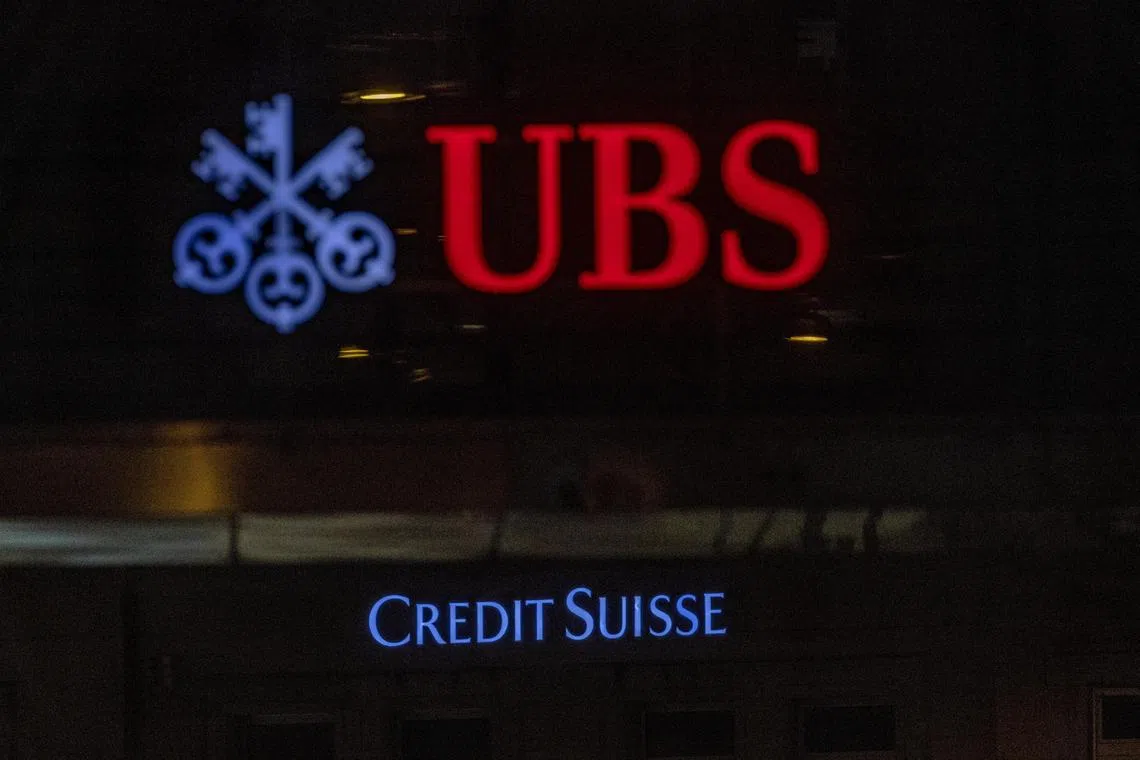Credit Suisse says $23 billion of debt now worthless, angering bond holders
Sign up now: Get ST's newsletters delivered to your inbox

Credit Suisse's deal with UBS will trigger a “complete write-down” of the bank’s additional tier 1 bonds.
PHOTO: REUTERS
Follow topic:
LONDON – Holders of Credit Suisse Group bonds suffered a historic loss when a takeover by UBS Group
The deal will trigger a “complete write-down” of the bank’s additional tier 1 (AT1) bonds. Swiss financial regulator Finma said the decision would bolster the bank’s capital. The move also reflected the authorities’ desire to see private investors share the pain from Credit Suisse’s troubles.
Meanwhile, the bank’s shareholders – who sit below bonds in the priority ladder for repayment in a bankruptcy process – are set to receive three billion francs under the UBS deal.
Credit Suisse’s holding company had 13 AT1 bonds – also known as contingent convertible bonds – outstanding issued in Swiss francs, United States dollars and Singapore dollars, according to data compiled by Bloomberg.
The bond wipeout is the biggest loss yet for Europe’s US$275 billion (S$368.4 billion) AT1 market, far eclipsing the only other write-down to date of this type of security: a €1.35 billion (S$1.9 billion) loss suffered by junior bond holders of Spanish lender Banco Popular back in 2017, when it was absorbed by Banco Santander for €1 to avoid a collapse. In that instance, the equity was also written off.
In a typical write-down scenario, shareholders are the first to take a hit before AT1 bonds face losses, as Credit Suisse also showed in a presentation to investors earlier last week. This is why the decision to write down the bank’s riskiest debt – rather than its shareholders – provoked a furious response from some of Credit Suisse’s AT1 bond holders.
“This just makes no sense,” said Mr Patrik Kauffmann, a portfolio manager at Aquila Asset Management. “This will be a total blow to the AT1 market. You can quote me on that.”
Mr Kauffmann believes that money should have gone to AT1 holders instead, leaving nothing for shareholders, as “seniority in the capital structure needs to be respected”.
Pacific Investment Management, Invesco and BlueBay Funds Management were among the many asset managers holding Credit Suisse AT1 notes, according to data compiled by Bloomberg. Their holdings may have changed or been sold entirely since their last regulatory filings.
UBS chief executive Ralph Hamers told analysts that the decision to write down the AT1 bonds to zero was taken by Finma, so they would not create a liability for the bank.
AT1 bonds were introduced in Europe after the global financial crisis to serve as shock absorbers when banks start to fail. They are designed to impose permanent losses on bond holders or be converted into equity if a bank’s capital ratios fall below a predetermined level, effectively propping up its balance sheet and allowing it to stay in business.
Prices on those bonds fluctuated wildly as traders gathered for a rare weekend session on Sunday to weigh two scenarios: either the regulator would nationalise part of or the whole bank, possibly writing off Credit Suisse’s AT1 bonds entirely; or a UBS buyout with potentially no losses for bond holders.
Prices oscillated between 20 cents on the dollar and as high as 70 cents when the deal was finalised. Following the Finma announcement, some trading desks simply updated their clients that a write-down had occurred.
The broader market for those risky European bank bonds has also tumbled in the past two weeks, with the average AT1 indicated at a price of about 80 per cent of face value on Friday, one of the steepest discounts on record.
For some investors, the fact that the UBS deal rendered the notes worthless came as no surprise, given their well-known downsides.
Holders of AT1s knew they were buying high-yield risk with “a hand grenade” attached to it, according to Mr John McClain, a portfolio manager at Brandywine Global Investment Management.
“It is absolutely the right thing to do to prevent moral hazard from creeping into that part of the market,” he said. “Those bonds were created for moments like this, similar to catastrophe bonds.” BLOOMBERG, REUTERS

